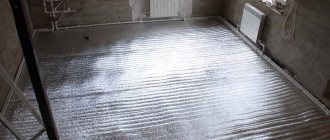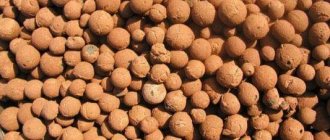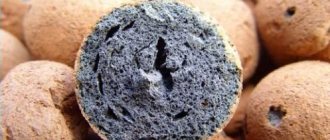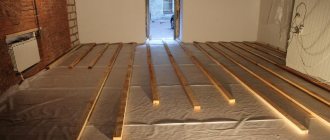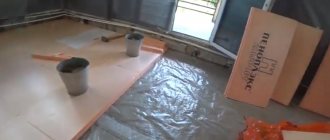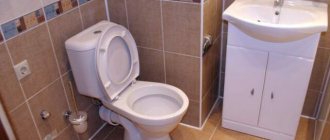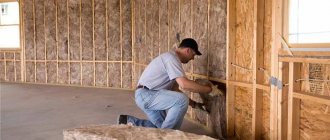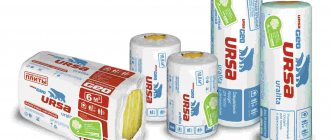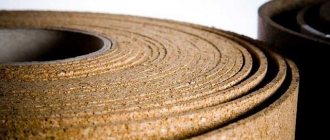No matter how modern and powerful the heating system is, without high-quality reliable thermal insulation its effectiveness is reduced to a minimum due to large heat loss. Expanded clay and mineral wool are most often used to insulate walls, roofs, floors or ceilings of residential buildings. It is impossible to say categorically which material is better. Both heat insulators have their positive and negative sides. Their heat-saving function depends not only on physical and technical indicators, but also on compliance with the rules for installing thermal insulation.
What is expanded clay
Expanded clay is a loose, porous, fairly lightweight building material. The main difference between expanded clay and other similar building materials is the use of special types of clay containing about 30% quartz as a base.
Expanded clay is produced by firing low-melting clay rocks that can quickly swell when heated to 1050-1300C for 30-40 minutes. As a result of thermal shock, round granules with a melted surface are formed.
We can say that expanded clay appeared thanks to defective clay bricks, when burned, sedimentary clay rocks swell. The release of gas and the transition of clay rock into a pyroplastic state during heat treatment is taken as the basis for the production of expanded clay. Most often, expanded clay is used to fill concrete structures and thermal insulation of foundations, floors, and roofs.
Natural and environmentally friendly
Expanded clay is a lightweight building material, it is produced by firing low-melting clays.
Expanded clay is a lightweight porous building material made from heaving clay. The latter, when fired by a special method of thermal shock, turns into solid round pieces of different sizes. The surface of such components is melted. Expanded clay is a bulk material that can “breathe”. It is highly lightweight, durable, and its porous structure helps it retain heat effectively. As insulation, it is often used for ceilings or floor backfill.
Expanded clay is not afraid of water; it is an absolutely environmentally friendly material, safe for humans.
There will be no rodents in it, and the room will be provided with excellent ventilation. Expanded clay does not burn, it is durable, resistant to low and high temperatures.
Expanded clay is distinguished by grain size, strength and density; The grain size ranges from 5mm to 40mm.
Expanded clay is usually divided into 5 groups according to the size of the granules - from large to small. Expanded clay is quite affordable in price, and the technology for laying it will not cause difficulties even for non-professionals. At the same time, expanded clay is economical - its 10 cm layer is equivalent in insulation to 25 cm of brickwork or boards. Using the example of floor insulation, we will consider the technology of laying the material. If the floor is earthen, it must be cleared of all old floor coverings and structures; a sand cushion 10 cm thick is carefully compacted in the prepared space. A layer of waterproofing is placed on top of it, preferably in a single sheet. If the space between the beams of a wooden floor is filled with expanded clay, sand and special preparations are not needed. Expanded clay is poured on top, its layer cannot be less than 15 cm, the exact calculation depends on the load on the floor and heating in the room.
For a more even installation, it is advisable to use several fractions of expanded clay to prevent subsidence and provide additional adhesion to the components. The expanded clay floor is leveled using a laser level and beacons. To give the material its original density, it is watered with liquid cement mortar. It is important that all the “balls” are solid, not crushed or flattened, since the deformation of the parts significantly affects the technical characteristics of the material as a whole. Expanded clay is recommended for those who value naturalness and environmental friendliness, who are not afraid of reducing the internal space of the room, since the expanded clay layer is quite thick, and strive to create a comfortable microclimate for the building.
What types of expanded clay are there?
Depending on the size and shape of the granules, they are distinguished:
- Expanded clay gravel. Oblong granules.
- Expanded clay crushed stone. Granules in the form of cubes with sharp corners.
- Expanded clay sand. Small granules, less than 5 mm in size.
The quality of expanded clay is affected by the size of the granules, bulk density, bulk density, porosity, and strength. The porosity of expanded clay comes in different structures, and its insulating properties depend on this. The more pores, the higher the heat-saving function of expanded clay. On the outside, the granules are usually brown in color, but on the break they are black.
Depending on the size of the grains, expanded clay is divided into fractions. According to GOST 9757-90, the following fractions of expanded clay are distinguished: 5-10, 10-20 and 20-40 mm. Material with granules smaller than 5 mm is classified as expanded clay sand.
Expanded clay is an advantageous insulation material
Expanded clay is a building material used for insulating floor coverings and for leveling uneven surfaces . Craftsmen produce porous tools by firing clay slate. Within half an hour, expanded clay at temperatures up to 1300 C o 2 takes on an oval shape.
Externally, the insulation is a bit like crushed stone and gravel. Experts present several types of expanded clay. Here are some of them:
- Expanded clay sand . Used to reduce the weight of concrete structures. A distinctive feature of construction raw materials is small sand granules.
- Gravel . The following type of expanded clay is used in several cases: to create lightweight concrete products and as drainage for flowerpots. The material exhibits rather large granules (up to 44 mm).
- Expanded clay crushed stone . An excellent and high-quality product is used as a filler for lightweight concrete. The presented raw materials are obtained by crushing expanded clay gravel.
Determining the type of building material is easy. Just look at the size of the expanded clay granules. We should not forget about the positive qualities of this insulation. The advantages of expanded clay are:
- Long service life . Flooring created from a clay product can outlast a typical nine-story building.
- High level of thermal conductivity . Expanded clay retains heat longer and better than other building resources. 10 times better than brick and 3 times better than wood.
- Low cost and light weight . Low weight allows you to insulate floors with expanded clay in small rooms without additional structures and special reinforcing frames.
- High strength . The presence of such quality expands the scope of application of clay raw materials. Expanded clay is used not only to insulate flooring, but also walls and even ceilings. Constant loads do not detract from its strength.
- Excellent sound insulation . This is a definite plus when insulating personal apartments in multi-storey buildings.
- Easy installation . Laying insulation does not require lengthy and multi-step preparatory work. It is enough to remove the old coating.
- Excellent resistance to severe frosts and heat, that is, resistant to temperature fluctuations. Resists fire well.
Low moisture resistance is the main and only disadvantage of expanded clay. In the construction world, other types of insulation are widely used. For example, mineral wool.
Performance characteristics of expanded clay
Thermal conductivity
High thermal insulation ability. The heat-saving properties of the material depend on the type of processing. Even a small expanded clay layer under the floor significantly increases the level of thermal insulation. The thermal protection of a 100 mm thick expanded clay layer is the same as a 250 mm thick layer of wood.
Weight
Due to its lightness, expanded clay insulation is used at all stages of the construction process. The weight of one cubic meter of expanded clay reaches 250 kg.
Sound protection
Expanded clay is characterized by a high degree of soundproofing. The soundproofing properties of expanded clay are important in housing construction.
Strength and Durability
Thanks to “hardening”, as a result of firing the clay and forming a strong sintered shell, the material becomes chemically inert, resistant to mechanical damage and temperature effects (frost resistance, at least 25 cycles).
It is not susceptible to rotting, damage by rodents and damage by fungus and mold.
Flowability
Expanded clay is used to fill spaces of any volume and geometric shape.
Environmental Safety
Expanded clay is a completely natural material. Does not contain toxic impurities.
Water resistance
Expanded clay is not susceptible to moisture. The water absorption of the material is 8–20%. Any insulation needs protection from moisture and vapor barrier. But even when moisture gets into the expanded clay layer, its granules act as drainage, thanks to the ventilated gaps. And the moisture gradually evaporates.
Affordable price
The material is relatively inexpensive. For example, one cubic meter of expanded clay gravel (fraction 10-20) can be purchased for 1,450 rubles, the price with delivery is 1,500 rubles. Expanded clay is sold both in bulk and packaged in bags.
Which is cheaper: comparison of the cost of two materials
1 cubic meter of expanded clay gravel can be bought for 1,500 rubles, 1 roll of mineral wool measuring 8200x1220x50 mm costs from 1,400 rubles.
The cost estimate for insulation should include costs for:
- for the services of loaders - for the delivery of heavy bags of expanded clay;
- additional consumables - timber, vapor barrier membrane, fasteners;
- personal protective equipment – important when using mineral wool insulation.
To simultaneously solve the problems of thermal insulation and sound insulation, it is clear that mineral wool is better. Expanded clay is not an insulation material, and the low cost of the material can be completely offset by the need to use it in large quantities.
Physical and technical characteristics of expanded clay
Bulk density
Expanded clay is assigned different grades depending on the size of the bulk volumetric mass. The total number of expanded clay grades varies from 250 to 800; the grade number indicates the bulk density of the material.
For example, expanded clay gravel 250 has a bulk density of 250 kg/m3. Analysis to determine bulk density by fraction is carried out by pouring expanded clay into measuring containers. The smaller the granules, the greater the bulk density.
Moisture absorption
This indicator expresses the percentage of dry filler weight. Unlike other fillers, expanded clay is protected from moisture penetration inside due to the presence of a burnt crust. The correlation coefficient of high-quality expanded clay is not lower than 0.46. The defective material has low granule porosity, which significantly increases the ability to absorb and retain moisture.
Deformability
The deformation coefficient is determined by the porous structure of the material. As a rule, after the first test cycle, the vast majority of material samples show a reliable shrinkage result. The permissible value of the deformation coefficient is no more than 0.14 mm/m.
Thermal conductivity
The thermal insulation properties of expanded clay are greatly influenced by the glassy phase of production. The higher the glass content, the lower the thermal conductivity of the material. Good quality expanded clay has a thermal conductivity of 0.07-0.16 W/m, which allows you to save up to 80% of heat.
Specific thermal insulation parameters of expanded clay and rolled insulators
So, it turns out that the advantages and disadvantages of materials are known, but what happens if we compare their thermal conductivity? Everything here is actually quite simple.
For a clear example, you just need to take good quality insulators.
| Minvata | Expanded clay |
| Approximately 0.04 W/m*K | Approximately 0.09 W/m*K |
As can be seen from the table, cotton wool insulation has a better level of thermal conductivity than expanded clay, which means that to achieve the same thermal conductivity effect, the expanded clay layer for the floor must be made twice as thick as it would be when using basalt rolls.
If we talk about exact figures, then in average climate conditions the required thickness of wool on the ceiling should be about 7 cm according to SNIPs. Accordingly, to fill the expanded clay you will need a space of about 13-17 centimeters (it all depends on the quality of the granules). Of course, the numbers may vary in one direction or another, since the specifics of the situation are of great importance, but in general the ratio is approximately the same.
Based on all the above information, we can draw some conclusions.
Expanded clay production method
Clay shale is fired in metal kilns in the form of drums with a diameter of 2-5 m and a length of up to 70 m. The drums are located at an angle of inclination. Shale granules are poured into the upper part of the furnace, they flow down the drum, where the nozzle for burning fuel is located. The firing time of the granules in the oven is 45 minutes.
There are double-drum ovens, in which the drums are separated by a threshold and rotate at different speeds. In such kilns, it is possible to process lower-quality raw materials and obtain expanded clay crushed stone or gravel at the output, which is not inferior to the material obtained in single-drum kilns.
Where is expanded clay used?
- Economical bulk insulation for walls, floors, building floors, basements, pitched roofs, as well as for the installation of heat and water supply networks. Good quality expanded clay gravel reduces heat loss in a building by 70-80%.
- Filler for lightweight concrete (expanded clay concrete). Production of expanded clay concrete blocks.
- Decorative material and at the same time a heat insulator for soil and lawns.
- Drainage material and thermal insulator for earthen road embankments in areas of water-saturated soil.
Reviews about mineral wool
Dmitry, 39 years old, Moscow: “I insulated the roof of the bathhouse with mineral wool. One winter has already passed, it is warm and dry. I checked through the inspection hatch - the insulation inside is dry, and there are no negative changes near the pipe either.”
Evgeniy, 44 years old, Volsk: “I insulated the inside of the loggia with mineral wool - the walls were under wooden lining and the floor was under OSB. I installed an electric radiator, and it turned out to be a small but cozy office.”
Methods for insulating floors with expanded clay
In modern construction, there are different ways to construct a subfloor. One of the frequently used ones is floor screed with expanded clay, which is performed both dry and wet.
Wet method
The use of expanded clay as a filler for concrete mortar adds strength to the structure. As a result of the penetration of the solution into the porous structure of the granules, the adhesion force of the concrete increases.
The content of cement and construction sand is 1:2 or 1:3. In the first case, a durable hard surface is obtained that can withstand heavy loads. Add enough water to obtain a fairly thick, homogeneous mass. Ready-made sand-cement compositions are available for sale, which are diluted with water in accordance with the instructions.
How to calculate expanded clay consumption
Calculation of expanded clay for floor screed is carried out taking into account the required thickness of the thermal insulation layer. Before you buy expanded clay and other screed materials, you need to calculate their quantity.
Usually they adhere to the following proportion: for 1 sq.m of screed 30 mm thick, 17 kg of cement and 50 kg of sand are required. Expanded clay consumption depends on the thickness of the insulation layer and the material fraction and is approximately one 50 kg bag, which is enough to construct a screed with an area of 4-5 m2.
Calculation of expanded clay for heated floors
The use of expanded clay allows you to use concrete mortar more economically. Laying a “warm floor” has its own characteristics, since the concrete-expanded clay coating experiences not only mechanical loads, but also temperature influences. In this case, the proportional content of cement and sand will be 1:2.
The amount of expanded clay depends on the thickness of the thermal insulation layer, for example, with a layer thickness of 10 mm, 0.01 m3 of material per 1 m2 is required. It is difficult to calculate in advance the exact consumption of expanded clay; often the required amount of material is determined experimentally during the construction process. A plasticizer is added to the concrete mixture for “warm floors” at the rate of 150-200 ml per 1 m2.
Procedure for laying expanded clay
Thermal insulation with expanded clay requires strict adherence to technology.
The procedure for insulating with expanded clay:
- Clean the floor. If the floor is made of wood, then remove all structures except for the mounting beams.
- Place beacons around the perimeter of the room, maintaining a small gap from the wall.
- Cover the surface with a 100 mm thick layer of sand and compact it.
- Pour expanded clay over the sand layer. The minimum thickness of the expanded clay layer should be at least 150 mm. It is determined taking into account the load on the floor.
- Level the surface of the expanded clay layer along the beacons using fishing line.
- Cover with a waterproofing film to protect the expanded clay insulation from moisture penetration.
- Pour concrete solution. Laying concrete requires care so as not to disturb the level of expanded clay. For 3-4 weeks, the floor is regularly moistened with water to avoid cracks.
Dry method
The peculiarity of dry screed technology is that no concrete mixture is used. The design consumption of expanded clay is 0.01 m3 per square meter of floor with a layer thickness of 10 mm. However, the calculation of expanded clay for dry screed is made for a layer thickness of 30-40 mm, which means that per 1 m2 of area, at least 0.03-0.04 m3 of material will be required.
In practice, the consumption of expanded clay may differ slightly from the calculated one due to various reasons: floor slope, change in screed area after installing beacons, etc.
How to replace expanded clay concrete, are there any analogues?
If it seems to you that expanded clay concrete is too heavy for your purposes, and specifically for bulk thermal insulation, you can turn to other porous and expanded backfills. In particular, it is similar to expanded clay concrete, similar in its characteristics to agloporite, a kind of pumice with a composition identical to glass. This filler is made from brick clays mixed with a mixture of coal and shale mining waste, as well as with ash and slag from the combustion chambers of thermal power plants. However, the environmental friendliness of this material is questionable. Another replacement for expanded clay concrete is expanded perlite sand, its moisture absorption is even lower than that of expanded clay concrete, only 3-5%, but its thermal conductivity is only 0.04, like basalt wool.
Insulating the floor of a country house with expanded clay
A country house can be insulated with expanded clay. The insulation layer must be at least 30 cm. When laying expanded clay directly on the ground, the floor will be cold. A more effective method is double flooring. A subfloor made of tightly fitted boards without gaps is attached to the beams. The flooring is covered with thin durable paper - glassine, which is used instead of roofing felt. Expanded clay is poured from above to the level of the middle of the beam. Then the finishing floor is laid.
Insulation materials require protection from moisture generated both inside the house and penetrating from the external environment. For this purpose, waterproofing membranes are used.
Insulation of the foundation from the inside. Why and how do they do this? on the Nedvio website
- Select House Cottages
- Houses in villages and villages
- Houses in SNT, DNP, DNT
- Houses in villages and villages
- Dachas
- Mansions and estates
- Duplexes
- Townhouses
- Cottage villages
- Ready-made, built villages
- New buildings, settlements under construction
- Without a contract
- Questions and answers
Question from a reader of our portal: Insulating the foundation from the inside. Why and how do they do this?
Answer: Internal insulation of the foundation is an important stage in the process of building or operating a house, and here’s why. The foundation is the most important building structure, on the “shoulders” of which lies the performance of many main functions. Depreciation of a living space is the main task of the foundation; however, an equally important function is to protect the lower log houses and basement from excess moisture. This protection is necessary throughout the year, since in winter, autumn, and spring, the basement and other lower parts of the house are exposed to floods and other unfavorable environmental conditions.
Why insulate the foundation from the inside?
Proper insulation of the foundation inside the house is the key to warmth and comfort in your home and other wooden buildings. The strength of the lower rims will depend on the correct performance of the thermal insulation work.
First you need to explain the importance of insulating the foundation from the inside. To understand this, you need to know about the existence of such a thing as temperature heaving of soil. Low temperatures freeze the moisture in the soil. After which the soil expands in the places where the foundation is laid, the blocks are pushed to the surface of the earth, and the wall structures are warped.
There is a foundation based on screw piles, in relation to which the level of soil compression does not matter. This is the main advantage of this type of foundation, which affects its popularity. But even the strongest pile-screw foundation is recommended to be insulated for greater durability.
What materials are best to use?
Typically, when choosing thermal insulation materials, builders look at two indicators - the thermal conductivity coefficient and the behavior of the material under real operating conditions.
Expanded polystyrene is considered the best option to maintain a balance between these properties. Insulating the foundation from the inside with polystyrene foam is especially common in mid-latitudes, where the coefficient of soil heaving and freezing is low. However, it is worth remembering that over time this material gradually depolymerizes, producing styrene.
The foundation is also insulated from the inside using cotton wool insulation and spray-on compounds, but they also have their drawbacks - the need to create a vapor-tight barrier and the inability to produce insulation yourself.
How to insulate the foundation from the inside of a house?
Modern technologies for thermal insulation of foundations on piles include several step-by-step procedures:
- Waterproofing the buried and above-ground layer of the grillage with waterproofing film or roofing felt;
- Laying polystyrene foam and polystyrene foam - insulation materials;
- Finishing the surface with sheets of plasterboard or using plastering.
This technology will allow you to create optimal conditions for the favorable operation of the building. If there are deposits of groundwater on your site, then you need to build a drainage hole to drain it and lay a layer of special material under the pile cap.
What is mineral wool
Mineral wool is one of the most common heat insulators, used in various types of insulation. Mineral wool is a soft, coarse-fiber building material. Mineral wool insulation is produced from metal waste and carbon alloys of minerals.
Mineral wool is widely in demand in construction due to its durability, simple and quick installation, and fire resistance. The disadvantage of this insulation is its reduced moisture resistance. To protect against dampness, the material is impregnated with special compounds.
The property of mineral wool such as breathability is especially valued. Due to its ability to “breathe”, mineral wool is often used to insulate wooden houses. Mineral wool insulation form: slabs, rolls, mats of various lengths and thicknesses. The choice of slab size depends on the conditions of thermal insulation installation and the upcoming tasks.
For summer houses, the insulation dimensions will be smaller. So for a panel country house you will need sheets 50 mm thick. Houses for year-round use require more thorough insulation; in this case, the required thickness of the mineral wool layer reaches 200 mm.
Styrofoam
Perhaps the most popular type of insulation used in private construction. Impeccable sound insulation and high thermal insulation are the main advantages of polystyrene foam. Since the material is made from different raw materials, the density of the finished product may vary. It is clear that the higher the density of the material, the higher the resistance to mechanical stress and the lower the degree of thermal insulation.
To insulate wooden floors, low-density foam is usually used. This choice is due to the fact that the insulation is placed between the rough and finished floor covering.
Since polystyrene foam is an artificially created material, it is absolutely “not interesting” to microorganisms and other pathogenic bacteria. But for rodents, foam plastic is a favorite habitat.
The advantages of the material include durability, accessibility and ease of installation.
The disadvantages of using polystyrene foam include low fire resistance. Moreover, when burning, the insulation emits toxic smoke, which is very toxic.
Photos from the Yandex.Pictures service
Photos from the Yandex.Pictures service
Performance characteristics of mineral wool
- Mineral wool is a fire-resistant material.
- Provides a high degree of sound insulation, which is especially important in residential buildings with thin walls.
- Not subject to deformation from exposure to high and low temperatures.
- Acceptable price. The cost of the material depends on the release form and size. For example, a set of mineral wool in rolls based on fiberglass for heat and sound insulation of various structures from two mats measuring 8200x1220x50 mm costs RUB 1,375.00.
Disadvantages of mineral wool insulation: the material is fragile and not moisture resistant. Mineral wool cannot be called an environmentally friendly insulation. Its particles, when inhaled, have a harmful effect on the human body.
These disadvantages are neutralized by proper handling of the material and compliance with thermal insulation installation technology.
Results
Having studied the question of how to insulate a house with expanded clay, it should be noted that it is used less and less. It is practically not used for residential buildings, since many still prefer modern thermal insulation materials. Insulation with expanded clay, according to reviews, is ineffective, since the thermal conductivity coefficient of this material is very high 0.1-0.18 W/m*C, while for mineral wool this value is 0.038 W/m*C, not to mention polyurethane foam with its 0.023 W/m*S. You can slightly increase the effectiveness of expanded clay by mixing it with sawdust. Practice shows that the method works.
Thermal insulation of the floor with mineral wool on joists
One of the ways to insulate a floor is to lay it on joists.
Floor insulation using joists is carried out on the ground. The underground space with this method will be cold. If the house is brick, then it is necessary to insulate the foundation of the house. This is caused by the high thermal conductivity of the brick and the possibility of the formation of cold bridges. Thermal insulation using the joist method is often carried out in wooden houses, since wood has lower thermal conductivity.
Modern insulation materials are very effective. But sometimes their use leads to freezing of the base in wooden buildings. This opposite effect is associated with the high tightness of modern heat insulators and the obstacle to heating the underground space due to the heat of the house. Therefore, when insulating a wooden house with modern materials, thermal insulation of the base is also required.
The procedure for floor insulation by joists
- Compacting the soil.
- Laying a layer of crushed stone bonded with bitumen mastic. Bitumen is used for waterproofing.
- Installation of brick columns with a longitudinal interval of 2 m and a transverse interval of 60 cm.
- Waterproofing of columns.
- Laying wooden logs with a cross-section of 100x50 mm, which is sufficient to withstand the load on the floor.
- Fixing a windproof layer at the bottom of each joist. First, a metal mesh is attached, and a wind-protective film is attached to it. This is necessary so that the insulation layer does not fly apart under the influence of air currents under the floor of the house. This film is vapor permeable.
- Laying mineral wool insulation on film between the joists. Mineral slabs with a windproof coating are now being produced. In this case, metal mesh and film are not required.
- Covering the insulation with a layer of vapor barrier.
- Sealing joints between sheets.
- Flooring made of planks.
If the floor is wooden on a concrete base, then remove the boards and everything under them and clean the concrete surface. If the boards are in good condition and they are planned to be re-laid after insulation, then note the order of their arrangement and carefully remove them.
Then spread the waterproofing film. Logs with a cross section of 50x50 mm are laid on top at a distance of 50 cm from each other. Insulation is placed between the joists. An overlapping vapor barrier film is attached on top with small slats. The final stage: laying the finished floor.
When insulating the floor with mineral wool, it should be taken into account that the height of the floor will rise by approximately 50 mm.
Peculiarities
Each type of heat-insulating material has its own characteristics and physical characteristics. However, when choosing, experts recommend focusing on the following:
- Type room. It can be residential or non-residential.
- Strength. Since the insulation is laid on the floor, it will experience certain loads.
- Lifetime. Floors are rarely re-laid, which means that the material must retain its insulating properties for a long time.
- Thermal insulation level;
- Weight and density;
- Degree of moisture absorption;
- Vapor barrier;
- Fire safety;
- Environmental friendliness;
- Material consumption when cutting (waste should be as little as possible);
- Easy to handle and install.
Professionals note that the heat-insulating material under the concrete screed must have the following qualities:
- High density, which determines rigidity. The latter is necessary in order to withstand the weight of the screed.
- Moisture resistance, since the concrete solution contains water.
- Lack of open cells and pores in slabs and rolls. Particles of screed become clogged in them.
- Low degree of heat transfer, which will allow the use of thinner insulation.
The main requirement for thermal protection for a wooden floor is vapor permeability.
The heat exchange throughout the room depends on the floors. Depending on the type of residential structure, installation features vary.
Floor insulation in an apartment of a frame house on screw piles has its own characteristics. Buildings on pile foundations are erected on moist soil. With such a design, the house, as a rule, has a ventilated basement or basement.
Experts advise insulating the floor in layers:
- A frame skeleton that also serves as a subfloor. Its installation begins with fastening wooden beams to the joists; they will support the rough flooring boards.
- Wind protection, which performs the function of protecting the insulation from weathering. For this purpose, special insulating membranes are used. Since they are characterized by high cost, they can be replaced with polyethylene, which should be laid on top of the insulation.
- A heat insulator, on which, if necessary, an additional waterproof layer is laid.
- A finished floor consisting of chipboard, plywood or other material.
As heat-insulating materials, it is better to pay attention to insulation materials with high resistance to moisture. For example, polystyrene foam is good both in terms of cost and performance properties, but it is destroyed in frost and high humidity. This means that in this case it is necessary to protect it from external influences.
Another option for heat insulation is mineral wool, produced in the form of rolls or slabs. It is very profitable because it is inexpensive, has fairly high thermal protection and is resistant to fire. However, experts note that when water gets inside, all insulating properties are reduced to zero. The most suitable option for a building on screw piles is wool in the form of blocks, which has a more dense structure.
Penoplex is also used for frame houses, but it is more expensive compared to polystyrene foam and mineral wool. You should pay attention to its advantages: reliability, durability and almost zero water absorption.
You can often see expanded clay as insulation, but it is inferior to the above materials in terms of heat-protective functions.
When arranging a living space, professionals insist on protecting the pile foundation with a permanent base, as it will provide additional protection from wind and snow. If this is not necessary, then it is enough to install a decorative option.
In addition to the existing standard technology, there are others:
- Double thermal insulation. The technology involves laying double flooring.
- Cross thermal insulation. The method involves a perpendicular arrangement of insulating layers.
When insulating a frame house on stilts, it is very important to follow all the technology, otherwise you may end up with poor-quality insulation with a damp underground, mold and mildew.
In a brick apartment building, residents of the first floors often complain about the icy floor. Experts recommend that before installing thermal protection, you need to clarify what type of coating is available.
Brick houses, as a rule, have either wooden or concrete floors. If there is a concrete surface, the insulation process must necessarily include waterproofing to prevent the appearance of mold.
Work begins with preparing the base: eliminating cracks and cracks using cement mortar. Then the floor is impregnated with a strengthening compound. Next, a layer of waterproofing is laid, which in its simplest form can be a polyethylene film. A primer with deep penetration properties should also cope with its role. Afterwards, roofing material is spread, a frame of longitudinal beams and transverse joists is installed, into which heat-insulating material is poured or poured. Mineral wool or polystyrene foam can be placed on top of the insulating layer inside the frame. The last thing to attach is a vapor barrier film, on top of which the subfloor is mounted.
The entire structure takes a certain distance between the floor and the ceiling, which should be taken into account during repairs.
You can use a less expensive option without an insulating bulk “cushion”. It is enough to use one of the polymer insulation materials laid on concrete, but waterproofing is required in any case.
If you have a wooden floor, it is first recommended to replace the old floors and eliminate cracks, treat all elements with antiseptics and dry thoroughly. Then install roll or block insulation and cover it with a vapor barrier. The final stage is installation of the finished floor.
An apartment on the ground floor can be insulated not only from the residential side, but also from the basement. For this purpose, the basement ceiling is sheathed with a heat insulator, which can be polystyrene foam or polystyrene foam. They are easy to install because they simply stick to the ceiling. It would be appropriate to use mineral wool, but its installation requires some effort.
To insulate concrete floors, it is better to choose high-density protective agents: expanded clay, mineral wool mats, expanded polystyrene. Eco- or mineral wool, as well as rolled materials, are appropriate as insulation for wooden bases.
The features of floor insulation in a Khrushchev building differ from previous options. The main design feature of Khrushchev buildings are reinforced concrete slabs on the floor. To insulate them, a screed is used, but you need to remember that its layer should not be thick, since the floors are not designed for this. As a rule, to obtain a warm floor, it is enough to line the surface with polystyrene foam and fill it with a thin screed. Experts do not prohibit the use of self-leveling floors.
Insulating the attic with mineral wool
To prevent the attic from being empty, it can be insulated and turned into an additional attic room or storage room. For thermal insulation of the attic space the following are used:
- Organic derivatives (polyurethane foam).
- Mineral wool materials.
- Bulk dry insulation (expanded clay).
For high-quality thermal insulation of the attic, all three types of materials are used and combined.
Mineral wool is well suited for insulating all surfaces of the attic: floors, walls and roof. Insulating an attic with mineral wool requires the additional use of external wind- and water-insulating polymer film. It is advisable to treat the metal surface of the roof with oil paint to prevent condensation during the cold season of the year.
Mineral wool has a loose structure and allows steam to pass through well, so the inside of the insulation is covered with a vapor barrier layer of foil polyethylene.
Mineral wool is used in the form of rolls and mats. The seams between individual fragments of insulation are carefully sealed with metallized adhesive tape.
Mineral wool is placed between the roof rafters, and on the floor - between the joists of the supporting structures. When performing thermal insulation work, it is very important to take into account the increased load on the support columns due to the weight of the insulation.
Therefore, before starting insulation measures in the attic, you should make sure of the strength of the supporting structures and the roof itself, and, if necessary, replace outdated worn parts.
How to insulate a roof with expanded clay
Since expanded clay is a bulk material, the technology for insulating a flat roof or floor and pitched roof is different. At all stages except preparatory.
Tools and materials
To insulate a roof with expanded clay, you need standard tools that every home craftsman and householder has:
- screwdriver;
- construction knife;
- hammer;
- tape measure, pencil and building level;
- a scoop that will be convenient for scooping up expanded clay;
- rule (can be replaced with a flat board);
- bucket.
Materials you will need:
- expanded clay sand, expanded clay gravel of fractions 5-10 mm and 10-20 mm in proportions 1:4:5;
- edged board with a thickness of 20-25 mm (for insulating the ceiling with expanded clay, it is replaced with timber 20×20 mm or 25×25 mm);
- vapor barrier;
- waterproofing membrane;
- wood screws, dowels, if the boards need to be attached to the concrete floor;
- reinforced tape;
- marking thread.
Boards and timber must be treated with an antiseptic and fire retardant and allowed to dry. If the roofing has already been installed, insulation of the attic with expanded clay is carried out only along the ceiling. It is impossible to attach the lathing for filling expanded clay from the inside to the rafters - under the weight of the material, the fastenings will weaken over time, which can lead to spillage of the insulation between the cells and even its avalanche-like descent with damage to the roof structure.
What layer of expanded clay is needed to insulate a house?
As when working with other types of heat-insulating materials, when insulating with expanded clay, the thickness of the layer depends on the standard value of the structure’s heat transfer resistance R, which is calculated according to SP 50.13330.2012 “Thermal protection of buildings.” In short, the R value depends on the type of structure and building, as well as the climate in the area where it is being built. This value must be calculated in the design documentation. If this is not the case or you are insulating the house with expanded clay without a design, then the required heat transfer resistance will have to be calculated independently.
With known R, you can determine which layer of expanded clay for insulation is needed in your case using a simple formula:
P=Rk
where P is the layer thickness in meters, and k is the thermal conductivity coefficient of expanded clay, which can be viewed on the packaging or obtained from the manufacturer. If this is not possible, the thermal conductivity coefficient is taken equal to 0.16 W/(m K).
For those who do not want to do calculations, we present the average values of insulation thickness in different situations. So, what layer of expanded clay is needed for insulation:
- in the southern regions - 20-25 mm;
- in central Russia for flat roofs - at least 40 mm;
- for a pitched roof - no more than 30 mm; if greater thickness is needed, it can be obtained with other types of insulation;
- for overlap - at least 30 mm, preferably 40 mm.
When making calculations, do not forget that the thickness of expanded clay insulation depends not only on the value of the required heat transfer resistance of the structure, but also on the bearing capacity of the foundation, walls and rafter system of the house. In this case, it is necessary to take into account the snow load, which even in the central zone of the Russian Federation, not to mention the northern regions, reaches hundreds of kilograms per unit area. Therefore, in the northern regions, expanded clay is usually not used for insulation.
How much expanded clay is needed for insulation?
You can calculate how much expanded clay you need to insulate a roof or attic floor using the formula:
V=h·S·n
where V is the volume of expanded clay in m3, h is the calculated thickness of the expanded clay layer in m, S is the insulation area in m2, n is the correction factor, which is taken equal to 1.05-1.2. This coefficient takes into account the shrinkage of expanded clay during its compaction.
The value of the correction factor depends on what exactly you want to insulate:
- for attic floors n=1.05;
- for pitched roofs n=1.1;
- for flat roofs n=1.2.
If there is such an opportunity, it is better to buy expanded clay with a margin of an additional 5-10%. The fact is that expanded clay in bulk and in large bags is several times cheaper compared to packages of several tens of liters that are sold in construction and gardening stores. The difference is so significant that it is often more profitable to buy extra hundreds of liters than to later buy the missing volume of expanded clay in small packages. In addition, in a private house, excess expanded clay can always be used for drainage of indoor plants or for constructing alpine slides.
Insulation of attic floors with expanded clay
Before starting work, the surface must be prepared: remove all debris and dust, seal uneven areas and cracks, if any. If you do not close the cracks, then no matter how much expanded clay you lay on the floor, a lot of fine dust will get into the living room, which will be difficult to remove.
Insulating the floor with expanded clay begins with laying a vapor barrier, which is installed with an overlap. The film must extend 20-25 cm onto walls and other structures. Places of overlap and joints of the vapor barrier with enclosing structures are carefully taped with reinforced tape. If the film is attached to the ceiling with paper clips or nails, the fastening points must also be sealed with tape.
A frame is made on top of the vapor barrier layer to fill the expanded clay. It is made of timber, which is attached in one or two rows.
When installing timber in one row, it is fastened in increments of 1-1.5 m. In this case, the thickness of the timber depends on what layer of expanded clay is needed for insulating the ceiling. For example, if the calculated insulation layer is 40 mm, then a 20×40 mm or 25×40 mm beam is used to install the frame. A single-row frame is easier to install, but in this case, each beam will be a cold bridge through which heat will leave the room below. To avoid this, the frame is made double-row.
For a two-row frame, take a beam whose thickness is equal to half the calculated thickness of the expanded clay layer for insulation. The first row is also fastened every 1-1.5 m, after which the gap between the planks is covered with expanded clay. Then a second row of timber is installed, which is fastened perpendicular to the first with the same pitch. This allows you to pour expanded clay onto the beams of the first row and almost completely remove cold bridges - they will remain only at the intersection points of the frame beams.
Regardless of what expanded clay you decide to use for ceiling insulation, backfilling of insulation always begins with a leveling layer of expanded clay sand. Typically its thickness is 5 mm. To spread the sand in an even layer, in the middle of the gap between the bars, a nylon thread is pulled parallel to them at the desired height. Then the sand is poured between the bars, compacted and leveled using the rule.
To make the insulation layer dense, the expanded clay gravel fractions are mixed. This is done either in a bucket or other container before filling, or a ready-made expanded clay mixture is ordered at the factory. Gravel is poured between the beams in a layer of 10-12 cm, compacted, then the same layer is poured again and compacted again until the required insulation thickness is achieved. The completely poured layer of expanded clay is leveled using the rule, using the upper edges of the frame as beacons. At this stage, insulation can be completed if the attic is not planned to be used for storing things and other tasks. If there are such plans, then you need to make a flooring on top of the expanded clay.
Before installing the flooring, the expanded clay is covered with another layer of vapor barrier according to the same rules: with an overlap, sealing the joints with reinforced tape. A boardwalk is made on top of the vapor barrier, using frame beams for support and fastening.
Insulation of a flat roof
Vapor barrier film is usually not used on a flat roof - if it is accidentally damaged when filling in expanded clay, the roof will begin to leak. Instead of film, the roof surface is first coated with two layers of primer. It is needed to increase the adhesion of bituminous materials to the concrete base.
Then bitumen mastic is applied to the primer, and bitumen roll waterproofing is applied on top of it. Another waterproofing option is self-leveling roofing. This coating is monolithic, elastic and very durable, so leaks are practically excluded. But self-leveling roofing is more expensive than conventional rolled bitumen coatings.
Next, they begin pouring expanded clay. The principle of backfilling is the same as for overlapping: first expanded clay sand, then mixed fractions of expanded clay gravel in layers of 10-12 cm and compacting them. Only on a flat roof a frame is not made, but as beacons along which the expanded clay layer is leveled, sections of marking cord stretched at the required height are used. It needs to be stretched parallel to one of the walls, and the distance between the markings should not be more than two meters, otherwise it will be difficult to pour the insulation evenly.
Then the expanded clay on the unused roof is simply covered with a vapor barrier film with overlaps and joints glued, and roofing felt is laid on top, which must be placed on the walls. For greater reliability, it is better to cover the parapets completely with roofing felt, including the top.
If you plan to make a terrace on a flat roof, then before pouring the expanded clay, a damper tape is laid close to the parapet. It is needed so that when the size of the screed increases under the influence of temperature, it does not crack. The width of the tape should completely cover the thickness of the expanded clay layer and the future screed. Next, the roof is completed in three steps:
- a reinforcing mesh is laid on top of the expanded clay layer;
- then pour the cement-sand screed with a layer of 40-50 mm;
- the screed is aligned with the beacons installed on the expanded clay and left to gain strength for about a month;
- the resulting base is again primed with a primer in two layers;
- Either bitumen waterproofing is laid on top of the screed, or a self-leveling roof is made.
You can already lay terrace boards, paving slabs on top of the finished waterproofing, or pour drainage with soil and plant plants - it all depends on what your plans are. By the way, according to reviews from owners of green roofs, expanded clay is preferable to other types of insulation, since it allows you to create a slope on a flat surface. This is necessary so that after particularly heavy rain the green roof does not turn into a swamp - excess moisture must be drained through the drainage into the drainage system, and without a slope this is impossible.
Insulation of a pitched roof with expanded clay
Bulk insulation and pitched roofing are such a rare combination that many are not sure whether expanded clay can be used for thermal insulation of such a roof. It cannot be said that expanded clay gravel is often used for this, but it does happen. Mainly in the southern regions, and also if the building is subject to increased fire safety requirements.
The insulation of a pitched roof with expanded clay is carried out on top of the rafters - this is how the expanded clay presses down the flooring with its weight, while when you try to install the frame from the inside, it will, on the contrary, work to break the fastenings. To do this, a decking made of edged boards 20-25 mm thick is attached to the rafters. If necessary, they can be replaced with OSB board of appropriate thickness or moisture-resistant plywood. It is important that there are no gaps in the flooring, so to install it you need to use either calibrated boards or bring regular edged boards to the standard dimensions using a surface planer.
A vapor barrier film with an overlap is laid on top of the finished flooring, which is secured with a construction stapler. In places of fastening, the vapor barrier must be glued with reinforced tape to prevent the penetration of water vapor through these holes.
A frame beam is attached to the flooring on metal corners, the thickness of which should be equal to the calculated thickness of the expanded clay layer. The beam is attached parallel to the cornice in increments of 0.5 m. Between the horizontal beams, vertical beams are installed in the same corners in increments of 1.5 m. They are needed to attach the second layer of boardwalk, which will hold the poured expanded clay. Along the gable overhangs, the ends of the beams are covered with boards of the appropriate width.
The resulting rectangular cells are sewn up from below with boards approximately to the middle. A mixture of expanded clay gravel of two fractions is poured into the cavity between two boardwalks and compacted. Expanded clay sand is not used for insulation of pitched roofs. More granules are added onto the compacted expanded clay until the cavity is completely filled. Next, another top board is attached to the vertical bars, the cavity is again filled with expanded clay and compacted, and so on until the roof is completely covered with the second layer of flooring.
Scheme for insulating a pitched roof with expanded clay
Unfortunately, loose insulation on inclined surfaces cannot be laid completely evenly. Gravity gets in the way. Therefore, there will be more expanded clay in the lower part of the cell than in the upper part. You'll have to come to terms with this. The resulting cold bridges are usually combated by installing a layer of insulation from the inside of the roof.
A waterproofing film is laid on the finished flooring, which is secured using a counter-lattice. Next, on top of the counter-lattice, you need to mount a sheathing or another continuous flooring, on which the roofing covering is laid.
Thermal insulation of the attic with expanded clay
Expanded clay is an excellent material for insulating attic spaces. The dry, loose expanded clay layer creates a well-ventilated space and at the same time retains heat. Expanded clay is usually used to insulate attic floors, and in some cases, for thermal insulation of gables and the roof itself.
The loose expanded clay layer allows moisture and air to pass through well, which is why a wind- and moisture-proof polymer layer is needed on the outside. It is recommended to leave a small ventilated gap between the roof and the expanded clay layer to allow moisture vapor to escape outside.
From the inside, the expanded clay layer needs vapor barrier protection. Expanded clay is filled into a special frame. This hides some of the space inside the attic. A special box is made on the floor, expanded clay is poured into it, and wooden or tile flooring is laid on top.
Expanded clay insulation is often supplemented with mineral wool or polyurethane foam, especially in the area of pipes where ventilation is most required. Expanded clay is poured into these places and carefully covered on all sides with moisture and windproof membranes.
Choosing insulation for the floor
Warm floor – warm home. This statement does not require proof. But you can insulate the floor for mere pennies, and by investing a lot of money and effort into a complex electric or water heating system.
Which insulation is best for the floor is decided by everyone for themselves, based on the design features of the room and the expected budget.
Expanded clay
Expanded clay is one of the cheapest and most accessible insulation materials..
Its advantages are obvious:
- Excellent thermal insulation and sound absorption characteristics;
- Fire resistance and resistance to temperature changes;
- Light weight – expanded clay only slightly weighs down the structure;
- Fired expanded clay granules do not harbor rodents.
Note! In order for expanded clay to retain heat, its layer must be 10-15 cm thick. This is perhaps the only serious disadvantage of insulation - raising the floor level and reducing the ceiling height (especially important for standard apartments).
Expanded clay has long been successfully used for floor insulation, pouring it under gypsum plasterboard sheets, pouring concrete or cement mortar onto it, constructing a floating screed.
So which is better: mineral wool or expanded clay?
Thermal insulation of buildings with mineral wool and expanded clay is considered the most common due to several factors: relatively inexpensive price, a fairly simple installation process and quite decent insulation quality.
The choice of one or another insulation depends on the specific construction conditions, financial and technical capabilities. In addition, expanded clay and mineral wool complement each other perfectly and are often used in combination. Expanded clay and mineral wool are time-tested materials that have become traditional in construction. And it seems that they are not going to give up their positions in the foreseeable future.
Materials and tools
To insulate a concrete floor and a rough wooden floor, you will need almost the same materials and tools. Therefore, we present a universal list. Materials you need to buy:
- expanded clay - fraction and grade depend on the location of the work;
- wooden beam for laying logs;
- sheets of plywood, OSB or GVL, if the floor installation will be without logs;
- wood screws for attaching the logs to the supporting beam through the top (long) or metal corners (U-shaped profile) from the side, 3-4 cm long;
- metal corners or U-shaped profile for attaching the timber to the concrete base;
- damper tape;
- polyethylene film or any other rolled waterproofing material (you can use polymer mixtures or bitumen mastics).
To perform the work you need a set of tools. You can buy it, collect it from friends and neighbors, or rent it. During the work you will have to use:
- a screwdriver with a powerful battery (replaces an electric drill);
- jigsaw or wood hacksaw;
- vibrating plate – necessary for compacting expanded clay when insulating an earthen floor;
- bucket;
- tape measure;
- a rule or a straight slat;
- a level, preferably a laser one;
- shovel;
- nail puller;
- marker or construction pencil;
- stapler;
- with a hammer if you bought nails instead of screws.
